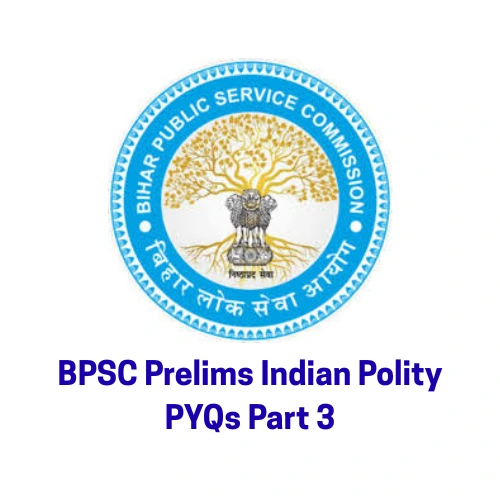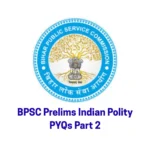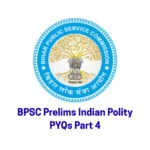BPSC Prelims Polity PYQs Part 3 generally include factual as well as conceptual questions from the Constitution, fundamental rights, directive principles, and Indian political system. Key topics like constitutional bodies (Election Commission, CAG, UPSC), non-constitutional bodies, and emergency provisions are repeatedly asked. Practicing PYQs helps in identifying recurring patterns and high-weightage areas.
BPSC Prelims Polity PYQs Part 3
In which year was the Railway Budget merged with the General Budget in India?
(a) 2015
(c) 2017
(b) 2016
(d) 2018
(e) None of the above/More than one of the above
Ans. (c)
What is the purpose of the Citizenship [Amendment] Act, 2019?
(a) To remove Bangladeshi illegal migrants
(b) To identify genuine Indian citizens
(c) To check border infiltration by foreigners.
(d) To grant citizenship to persecuted minority groups of Afghanistan, Bangladesh and Pakistan.
(e) None of the above/More than one of the above
Ans. (d)
Which Union Territory formed after division of Jammu and Kashmir State does not have a legislature of its own?
(a) Jammu
(b) Kashmir
(c) Ladakh
(d) Both Kashmir and Ladakh
(e) None of the above/More than one of the above
Ans. (c)
The First Session of Constituent Assembly was held on
(a) 9th December, 1946
(b) 15th August, 1947
(c) 26th November, 1949
(d) 26th January, 1946
(e) None of the above/More than one of the above
Ans. (a)
BPSC Prelims Polity PYQs Part 3
Electoral College for the election of the President of India consists of
(a) All the elected members of the Rajya Sabha
(b) All the elected members of the Lok Sabha
(c) All the members of the State Legislative Assemblies
(d) All the elected members of both the Houses of Parliament and elected members of the State legislative assemblies
(e) None of the above/More than one of the above
Ans. (d)
What constitutes the definition of “Money Bill” under Article 110 of the Indian constitution?
(a) The imposition or alteration in regulation of tax.
(b) The regulation of borrowings of money.
(c) The appropriation of money from the consolidated fund of India.
(d) Declaration of any expenditure to be charged on the consolidated fund of India
(e) None of the above/More than one of the above
Ans. (e)
The Supreme court’s judgment of Indra Sawhney Vs Union of India case is related to which issue?
(a) Regarding the issues of OBC reservation in government employment.
(b) Basic Structure theory
(c) Approval of reservation in promotion for SC.
(d) Extension of reservation for ST
(e) None of the above/More than one of the above
Ans. (a)
To be recognized as the National Party in India, a party must have secured at least how much percentage of votes in the previous election?
(a) At least 10% of valid votes in four or more states.
(b) At least 4% of valid votes in four or more states.
(c) At least 15% of valid votes in two states.
(d) At least 6% of valid votes polled in any four or more states.
(e) None of the above/More than one of the above
Ans. (d)
Indian Polity PYQs with Answers
What is the object of Cut Motion?
(a) To put check on the policies of the Government.
(b) To stop the functioning of ruling party
(c) To move proposals to reduce expenditure in the Budget proposals
(d) Rejection of complete financial dealings of the Government.
(e) None of the above/More than one of the above
Ans. (c)
Match List-I with List-II and select the correct answer using the codes given below:
| List-1 | List-11 |
| A. Formation of Village Panchayat | 1. Article 44 |
| B. Uniform Civil Code | 2. Article 48 |
| C. Agriculture and Animal Husbandry | 3. Article 50 |
| D. Separation of Judiciary from executive. | 4. Article 51 |
| E. Promotion of International Peace | 5. Article 40 |
(a) cite_start, (B-4), (C-2), (D-1), (E-5)
(b) cite_start, (B-3), (C-2), (D-1), (E-4)
(c) cite_start, (B-3), (C-5), (D-4), (E-1)
(d) cite_start, (B-5), (C-3), (D-4), (E-2)
(e) None of the above/More than one of the above
Ans. (e)
Which of the following Constitutional Amendment Acts restricted the Council of Ministers to 15% of the total members of the Lok Sabha?
(a) 95th Constitutional Amendment Act, 2009
(b) 93rd Constitutional Amendment Act, 2005
(c) 91st Constitutional Amendment Act, 2003
(d) 90th Constitutional Amendment Act, 2002
(e) None of the above/More than one of the above
Ans. (c)
Match List-I with List-II and select the correct answer using the codes given below: List-l List-11 A. C.H Hanumantha Rao 1. 1985 B. G.V.K Rao 2. 1986 C. Ashok Mehta 3. 1984 D. L.M Singhvi 4. 1957 E. Balwant Rai Mehta 5. 1978 (a) (B-5), (C-1), (D-3), (E-2) (b) (B-4), (C-1), (D-3), (E-5) (c) (B-3), (C-2), (D-4), (E-1) (d) (B-1), (C-5), (D-2), (E-4) (e) None of the above/More than one of the above Ans. (d)
BPSC Prelims Polity PYQs Part 3
What is Track 1.5 Diplomacy?
(a) Government Diplomacy
(b) Non Government Diplomacy
(c) Government Diplomacy and Non Government Diplomacy
(d) The United Nation Diplomacy
(e) None of the above/More than one of the above
Ans. (c)
Prevention of Cruelty to animals is listed in which list of the Indian constitution?
(a) Union List
(b) State List
(c) Concurrent list
(d) Preamble
(e) None of the above/More than one of the above
Ans. (c)
Which Article in the Indian Constitution is related with the establishment of the Election Commission of India?
(a) Article 324
(b) Article 148
(c) Article 342
(d) Article 325
(e) None of the above/More than one of the above
Ans. (a)
What is meant by “Rule of Law”?
(a) One act for all and One Judiciary for all
(b) One Act for all and One State for all
(c) One State for all and One Judiciary for all
(d) All acts for one and one Judiciary for all
(e) None of the above/More than one of the above
Ans. (a)
Indian Polity PYQs with Answers
Which Article gives the list of 29 functions to be performed by the Panchayati Raj Institutions?
(a) Article 243 (H)
(b) Article 243 (E)
(c) Article 243 (F)
(d) Article 243 (G)
(e) None of the above/More than one of the above
Ans. (d)
When was the Citizenship (Amendment) Act passed?
(a) 11th December, 2018
(b) 11th December, 2019
(c) 11th October, 2019
(d) 11th October, 2020
(e) None of the above/More than one of the above
Ans. (b)
The legislative origins of the 73rd Constitutional Amendment Act can be traced back to which Constitutional Amendment Bill?
(a) 61st Constitutional Amendment Bill
(b) 62nd Constitutional Amendment Bill
(c) 63rd Constitutional Amendment Bill
(d) 64th Constitutional Amendment Bill
(e) None of the above/More than one of the above
Ans. (d)
Which of the following is not the characteristics of decentralization?
(a) Autonomy
(b) People’s Participation.
(c) To instill non confidence among local communities.
(d) To empower local communities.
(e) None of the above/More than one of the above
Ans. (c)
BPSC Prelims Polity PYQs Part 3
Which act is not the landmarks in the development of the Constitution during the British rule?
(a) The Regulating Act, 1773
(b) The Charter Act, 1833
(c) The Government of India Act, 1919.
(d) The Protection of Civil Rights Act, 1955
(e) None of the above/More than one of the above
Ans. (d)
About which act, Jawaharlal Nehru had said, We were provided with a car with all brakes and no engine?
(a) Act of 1858
(b) Act of 1909
(c) Act of 1919
(d) Act of 1935
(e) None of the above/More than one of the above
Ans. (d)
Which of the following Indian states has the largest number of members in its State legislature?
(a) Arunachal Pradesh
(b) Himachal Pradesh
(c) Manipur
(d) Meghalaya
(e) None of the above/More than one of the above
Ans. (b)
In the Indian Order of Precedence, who amongst the following comes first?
(a) The Chairman of UPSC
(b) The Chief Election Commissioner
(c) The Comptroller and Auditor General
(d) The Chief Justice of High court.
(e) None of the above/More than one of the above
Ans. (e)


